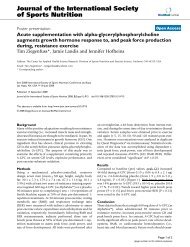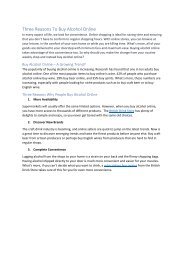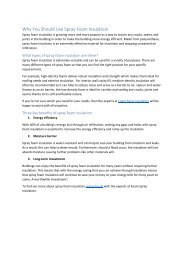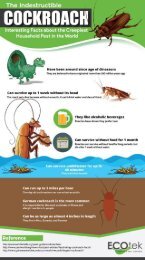Phallosan Forte
https://malehealthreview.com/ Phallosan Forte, Male Health Review
https://malehealthreview.com/
Phallosan Forte, Male Health Review
You also want an ePaper? Increase the reach of your titles
YUMPU automatically turns print PDFs into web optimized ePapers that Google loves.
<strong>Phallosan</strong> Study<br />
Statistical Report<br />
Author: Dr. Clemens Tilke<br />
15 April 2005<br />
1/36
Table of Contents<br />
Table of Contents ................................................................................................................................... 2<br />
Introduction ............................................................................................................................................. 3<br />
Age of patients ....................................................................................................................................... 4<br />
Body weight ........................................................................................................................................... 6<br />
Penis girth ............................................................................................................................................... 8<br />
Length of flaccid penis.......................................................................................................................... 12<br />
Length of erect penis ............................................................................................................................. 16<br />
Length of wear ...................................................................................................................................... 20<br />
Penis deviation ..................................................................................................................................... 21<br />
Erection behaviour ............................................................................................................................... 22<br />
Duration of erection .............................................................................................................................. 23<br />
Erection hardness ................................................................................................................................. 24<br />
Ejaculation ............................................................................................................................................ 25<br />
Sensitivity ............................................................................................................................................. 26<br />
Libido .................................................................................................................................................... 27<br />
Satisfaction ........................................................................................................................................... 28<br />
Cross-classification erection of behaviour and duration of erection .................................................... 30<br />
Cross-classification of erection behaviour and ejaculation .................................................................. 30<br />
Cross-classification of erection behaviour and ejaculation .................................................................. 30<br />
Cross-classification of sensitivity and libido ........................................................................................ 31<br />
Correlation of penis girth at the start of the study and subsequent change .......................................... 32<br />
Correlation of flaccid penis length at the start of the study and subsequent change ............................ 33<br />
Correlation of erect penis length at the start of the study and subsequent change ............................... 34<br />
Inference statistics ................................................................................................................................ 35<br />
Primary hypothesis ............................................................................................................................ 35<br />
Secondary hypothesis ........................................................................................................................ 35<br />
List of figures ...................................................................................................................................... 36<br />
2/36
Introduction<br />
<strong>Phallosan</strong> is an orthopaedic stretch belt for penis enlargement which was launched on the market in<br />
1999. Between July 2005 and January 2005 a study of the effectiveness of <strong>Phallosan</strong> was carried out<br />
under the patronage of Professor Dr. Sohn, Chief Physician at the Urological Clinic at the Markus<br />
Hospital in Frankfurt am Main. The data was collected by the clinic’s Senior Consultant, Dr. Hanikel.<br />
The results of 24 patients from the study were used for evaluation purposes. Two patients were<br />
classified as dropouts, but these had no post-baseline measurements and have been excluded from the<br />
analyses. They were only included in the analysis of satisfaction levels in the form of a worst-case<br />
analysis and classed as dissatisfied. A further 5 patients were marked ‘to follow’ in the study data and<br />
have been excluded (for the time being) from the analysis.<br />
The main purpose of this statistical report is to determine whether a (statistically) significant change<br />
in penis girth and length can be identified after using <strong>Phallosan</strong> for six months. For this purpose,<br />
univariate characteristics were calculated for these parameters and t-tests conducted of the significance<br />
of the enlargement. An allowance was made for the fact that due to repeated application of the test it<br />
was a multiple test problem.<br />
3/36
Age of patients<br />
The following table shows univariate characteristics of age distribution of the patients.<br />
Minimum .25- Median Mean .75- Maximum Variance Standard<br />
quantile<br />
quantile<br />
variation<br />
20.0 27.5 41.5 41.4 52.5 68.0 197.9 14.1<br />
The youngest patient was 20 years old, the oldest 68 years old. The mean and median values of 41.4<br />
and 41.5 closely approximated each other. The following boxplot and histogram show a graphical<br />
representation of the distribution.<br />
Figure 1: Boxplot of age 1<br />
1 Boxplot of age<br />
4/36
Figure 2: Histogram of age 2<br />
2 Histogram of age<br />
5/36
Body weight<br />
The variable body weight was measured at both the start and end of the study.<br />
The following table summarizes the results at the start of study.<br />
Start of<br />
study<br />
After 6<br />
months<br />
Minimum .25<br />
quantile<br />
Median Mean .75<br />
quantile<br />
Maximum Variance Standard<br />
variation<br />
65.5 73.7 82.2 82.9 86.7 129.0 178.1 13.3<br />
66.0 74.8 82.2 83.6 86.9 129.9 172.8 13.1<br />
Only slight changes in these variables appeared in the course of the study.<br />
The minimum body weight at the start of the study was 65.5 kg, the maximum 129.0 kg. Here again,<br />
the mean and median values of 82.9 and 82.2 closely approximated each other. This remained the case<br />
at the end of the study, when the mean value was 83.6 kg and median 82.2 kg.<br />
Two patients weighed more than 100 kg. At 129.0 kg Patient No. 17 was significantly heavier than all<br />
other patients. This is also clearly recognizable in the following boxplot, in which this patient is<br />
classified as a runaway.<br />
Figure 3: Boxplot of body weight 3<br />
The histogram also clearly shows Patient No. 17 as a runaway.<br />
3 Boxplot of body weight<br />
6/36
Figure 4: Histogram of body weight 4<br />
4 Histogram of body weight<br />
7/36
Penis girth<br />
Penis girth was measured three times: at the start of the study, then 3 months and 6 months into the<br />
study. The following table shows the univariate characteristics.<br />
Start of<br />
study<br />
After 3<br />
months<br />
After 6<br />
months<br />
Minimum .25<br />
quantile<br />
Median Mean .75<br />
quantile<br />
Maximum Variance Standard<br />
variation<br />
9.50 10.00 10.40 10.60 11.50 12.70 0.94 0.97<br />
9.50 10.50 11.50 11.30 11.85 13.50 1.14 1.07<br />
9.70 10.50 11.50 11.40 11.90 13.50 1.14 1.07<br />
The minimum penis girth at the start of study was 9.50 cm, the maximum 12.70 cm. The mean was<br />
10.60 cm with a standard variation of slightly less than 1 cm.<br />
After 3 months the minimum size remained at 9.50 cm, but an increase was determined in both the<br />
mean at 11.30 cm and the maximum at 13.50 cm.<br />
After 6 months the minimum size at 9.70 cm had somewhat increased compared to previous<br />
measurements. The mean was 11.40 cm and the maximum 13.50 cm.<br />
The following figure shows the boxplots in the course of time for penis girth.<br />
Figure 5: Penis girth in the course of time 5<br />
5 Penis girth in the course of time<br />
8/36
As can be seen from the table, the distributions after 3 months and after 6 months are very similar.<br />
The following figure shows the histogram of penis girth at the various points in time.<br />
Figure 6: Histogram of penis girth 6<br />
The following table shows the change in penis girth after 3 and 6 months.<br />
After 3<br />
months<br />
After 6<br />
months<br />
Minimum .25<br />
quantile<br />
Median Mean .75<br />
quantile<br />
Maximum Variance Standard<br />
variation<br />
0.00 0.00 0.40 0.64 1.05 2.50 0.56 0.75<br />
0.00 0.20 0.50 0.80 1.50 2.50 0.54 0.73<br />
On average, penis girth increased by 0.64 cm after 3 months and by 0.80 cm after 6 months. The<br />
minimum and maximum increases in both cases were 0.00 and 2.50 cm respectively.<br />
The following boxplot shows the changes in penis girth.<br />
6 Histogram of penis girth<br />
9/36
Figure 7: Boxplot of change in penis girth 7<br />
The graph clearly shows the change in the two quartiles, whilst maximum and minimum have<br />
remained unchanged.<br />
The last graph is the histogram.<br />
7 Boxplot of change in penis girth<br />
10/36
Figure 8: Histogram of change in penis girth 8<br />
8 Histogram of change in penis girth<br />
11/36
Length of flaccid penis<br />
In this section we examined the length of the flaccid penis. The following table shows the univariate<br />
figures at all three examination points.<br />
Start of<br />
study<br />
After 3<br />
months<br />
After 6<br />
months<br />
Minimum .25<br />
quantile<br />
Median Mean .75<br />
quantile<br />
Maximum Variance Standard<br />
variation<br />
4.80 6.85 8.00 7.90 9.15 10.80 2.61 1.62<br />
5.50 7.65 8.85 8.74 9.70 12.00 2.55 1.60<br />
6.70 8.40 9.00 9.38 10.40 13.40 2.53 1.59<br />
At the outset of the study the mean was 7.90 cm, the minimum 4.80 cm and the maximum 10.80 cm.<br />
The mean increased to over 8.74 cm after 3 months and 9.38 cm after 6 months. During this time the<br />
standard variation remained virtually constant.<br />
Figure 9: Boxplot of flaccid penis length 9<br />
The change in penis length is clearly visible in the boxplot.<br />
Figure 10: Histogram of flaccid penis length 10<br />
9 Boxplot of flaccid penis length<br />
12/36
Figure 10: Histogram of flaccid penis length 10<br />
As can be seen in the representation of penis length in the course of time, the penis increased in length<br />
over the given period. The following table summarizes the changes at the two points in time.<br />
After 3<br />
months<br />
After 6<br />
months<br />
Minimum .25<br />
quantile<br />
Median Mean .75<br />
quantile<br />
Maximum Variance Standard<br />
variation<br />
0.00 0.40 0.70 0.83 0.95 3.50 0.70 0.84<br />
0.20 0.85 1.30 1.47 1.80 4.90 1.04 1.02<br />
The mean change after 3 months was 0.83 cm, the maximum was 3.50 cm. After 6 months the mean<br />
increased to 1.47 cm and the maximum to 4.90 cm. In both cases the maximum was attributable to<br />
Patient No. 26.<br />
The following figure shows the boxplot of change.<br />
10 Histogram of flaccid penis length<br />
13/36
Figure 11: Boxplot of change in flaccid penis length 11<br />
The increase in length is clearly visible in the boxplots. It is also evident that further lengthening took<br />
place after the first 3 months. Due to limited scattering of data in the change after 3 months, four<br />
patients were classified as runaways. After 6 months this applied only to the patient with the greatest<br />
increase in size.<br />
11 Boxplot of change in flaccid penis length<br />
14/36
Figure 12: Histogram of change of flaccid penis length 12<br />
12 Histogram of change of flaccid penis length<br />
15/36
Length of the erect penis<br />
We now turn to the length of the penis when erect. The following table shows the univariate statistics<br />
at all three times of measurement.<br />
Start of<br />
study<br />
After 3<br />
months<br />
After 6<br />
months<br />
Minimum .25<br />
quantile<br />
Median Mean .75<br />
quantile<br />
Maximum Variance Standard<br />
variation<br />
8.70 10.85 12.00 12.30 13.90 15.50 3.11 1.76<br />
10.50 12.10 13.20 13.40 14.35 16.00 2.58 1.61<br />
11.00 12.90 13.90 14.10 15.25 16.50 2.44 1.56<br />
The mean changed in the course of time from 12.30 cm to 13.40 cm and 14.10 cm. There was only a<br />
relatively slight change in the maximum (from 15.50 cm at the start of the study to 16.50 cm after 6<br />
months). In contrast, there was a significant change in the minimum value from 8.70 cm to 11.00 cm.<br />
This is also shown in the limited variance of data.<br />
Figure 13: Boxplot of penis length when erect 13<br />
The boxplot clearly shows the change in penis length over the course of time.<br />
13 Boxplot of penis length when erect<br />
16/36
Figure 14: Histogram of penis length when erect 14<br />
As can be seen in the representation of penis length in the course of time, the penis increased in length<br />
over the given period. The following table summarizes the changes at the two points in time.<br />
After 3<br />
months<br />
After 6<br />
months<br />
Minimum .25<br />
quantile<br />
Median Mean .75<br />
quantile<br />
Maximum Variance Standard<br />
variation<br />
0.00 0.50 0.90 1.05 1.45 3.80 0.81 0.90<br />
0.50 1.00 1.60 1.78 2.10 4.80 1.08 1.04<br />
The mean change after 3 months was 1.05 cm, the maximum 3.80 cm. After 6 months the mean<br />
increased to 1.78 cm, the maximum to 4.80 cm. In both cases the maximum was attributable to Patient<br />
No. 3.<br />
The following figure shows the boxplot of change.<br />
14 Histogram of penis length when erect<br />
17/36
Figure 15: Boxplot of change in erect penis length 15<br />
The increase in length can be clearly seen in the boxplots. It is also evident that further lengthening<br />
takes place after the first 3 months.<br />
15 Boxplot of change in erect penis length<br />
18/36
Figure 16: Histogram of change in erect penis length 16<br />
16 Histogram of change in erect penis length<br />
19/36
Length of wear<br />
The following table shows univariate characteristics of length of wear per day.<br />
Minimum .25<br />
quantile<br />
Median Mean .75<br />
quantile<br />
Maximum Variance Standard<br />
variation<br />
2.00 4.00 6.50 6.23 8.00 10.00 5.35 2.31<br />
On average, <strong>Phallosan</strong> was worn for more than 6 hours. The maximum was 10.00 hours, the minimum<br />
2.00 hours.<br />
The following boxplot and histogram contain a graphic representation of distribution.<br />
Figure 17: Boxplot of length of wear 17<br />
17 Boxplot of length of wear<br />
20/36
Figure 18: Histogram of length of wear 18<br />
Penis deviation<br />
A value of 60° was determined in one patient at the start of the study. After using <strong>Phallosan</strong> for six<br />
months this declined to 40°. No other patient showed any deviation.<br />
18 Histogram of length of wear<br />
21/36
Erection behaviour<br />
When asked about erection behaviour after using <strong>Phallosan</strong> for six months, the patients responded<br />
with ‘unchanged’ or ‘better’. The frequencies are summarized in the following table.<br />
Unchanged Better<br />
Frequency 11 13<br />
Percentage 45.8 54.2<br />
Over half of the patients stated that their erections were better after 6 months that at the outset of the<br />
study.<br />
The following pie chart contains a graphic representation of these results.<br />
Figure 19: Pie chart of erection behaviour 19<br />
19 Pie chart of erection behaviour<br />
22/36
Duration of erection<br />
When asked about the duration of their erection, the patients the responded with ‘unchanged’ or<br />
‘longer’. The frequencies are summarized in the following table.<br />
Unchanged Longer<br />
Frequency 18 6<br />
Percentage 75.0 25.0<br />
One in four patients claimed to have a longer erection.<br />
The following pie chart contains a graphic representation of these results.<br />
Figure 20: Pie chart of duration of erection 20<br />
20 Pie chart of duration of erection<br />
23/36
Erection hardness<br />
When asked about erection hardness, the patients the responded with ‘unchanged’ or ‘harder’. The<br />
frequencies are summarized in the following table.<br />
Unchanged Harder<br />
Frequency 12 12<br />
Percentage 50.0 50.0<br />
Half of the patients claimed that their erection was harder than at the start of the study.<br />
The following pie chart contains a graphic representation of these results.<br />
Figure 21: Pie chart of erection hardness 21<br />
21 Pie chart of erection hardness<br />
24/36
Ejaculation<br />
When asked about ejaculation, the patients the responded with ‘unchanged’ or ‘later’. The frequencies<br />
are summarized in the following table.<br />
Unchanged Later<br />
Frequency 19 5<br />
Percentage 79.2 20.8<br />
Approximately one in five patients claimed a longer period until ejaculation.<br />
The following pie chart contains a graphic representation of these results.<br />
Figure 22: Pie chart of ejaculation 22<br />
22 Pie chart of ejaculation<br />
25/36
Sensitivity<br />
When asked about sensitivity, the patients the responded with ‘less’, ‘unchanged’ or ‘better’. The<br />
frequencies are summarized in the following table.<br />
Less Unchanged Better<br />
Frequency 1 13 10<br />
Percentage 4.2 54.2 41.7<br />
In one case sensitivity was stated as ‘less’. Over 40% of the patients claimed improved sensitivity.<br />
The following pie chart contains a graphic representation of these results.<br />
Figure 23: Pie chart of sensitivity 23<br />
23 Pie chart of sensitivity<br />
Due to rounding differences the total is higher than 100%<br />
26/36
Libido<br />
When asked about libido, the patients the responded with ‘unchanged’ or ‘better’. The frequencies are<br />
summarized in the following table.<br />
Unchanged Better<br />
Frequency 13 11<br />
Percentage 54.2 45.8<br />
Almost half of the patients claimed improved libido.<br />
The following pie chart contains a graphic representation of these results.<br />
Figure 24: Pie chart of libido 24<br />
24 Pie chart of libido<br />
27/36
Satisfaction<br />
At the end of the study the patients were asked about their level of satisfaction with <strong>Phallosan</strong>. The<br />
frequencies are summarized in the following table. Only patients who completed the study were<br />
included.<br />
No<br />
Yes<br />
Frequency 2 22<br />
Percentage 8.3 91.7<br />
Over 90% of patients were satisfied with <strong>Phallosan</strong> after using it for six months.<br />
The following pie chart contains a graphic representation of these results.<br />
Figure 25: Pie chart of satisfaction level 25<br />
25 Pie chart of satisfaction level<br />
28/36
Assuming the dropouts were also ‘dissatisfied’ with <strong>Phallosan</strong>, the following table results.<br />
No<br />
Yes<br />
Frequency 4 22<br />
Percentage 15.4 84.6<br />
According to this, almost 85% of the patients were satisfied with <strong>Phallosan</strong> after using it for six<br />
months.<br />
The following pie chart contains a graphic representation of these results.<br />
Figure 26: Pie chart of satisfaction level of dropouts 26<br />
26 Pie chart of satisfaction level of dropouts<br />
29/36
Cross-classification of erection behaviour and duration of erection<br />
Duration of erection<br />
Erection behaviour Longer Unchanged<br />
5 8<br />
Better<br />
20.8% 33.3%<br />
1 10<br />
Unchnaged<br />
4.2% 41.7%<br />
The largest patient group (41,7%) rated both erection behaviour and duration of erection as<br />
unchanged.<br />
Cross-classification of erection behaviour and ejaculation<br />
27<br />
Ejaculation<br />
Erection behaviour Later Unchanged<br />
5 8<br />
Better<br />
20.8% 33.3%<br />
0 11<br />
Unchanged<br />
0.0% 45.8%<br />
The largest patient group (45,8%) rated both erection behaviour and ejaculation as unchanged.<br />
Cross-classification of erection behaviour and ejaculation<br />
Ejaculation<br />
Erection behaviour Later Unchanged<br />
2 4<br />
Better<br />
8.3% 16.7%<br />
3 15<br />
Unchanged<br />
12.5% 62.5%<br />
Most of the patients (62,5%) rated both erection behaviour and ejaculation as unchanged.<br />
27 Due to rounding differences the total is not 100%<br />
30/36
Cross-classification of sensitivity and libido<br />
28<br />
Libido<br />
Sensitivity Better Unchanged<br />
8 2<br />
Better<br />
33.3% 8.3%<br />
2 11<br />
Unchanged<br />
8.3% 45.8%<br />
1 0<br />
Less<br />
4.2% 0.0%<br />
The largest patient group (45.8%) rated both sensitivity and libido as unchanged.<br />
28 Due to rounding differences the total is not 100%<br />
31/36
Investigation of the correlation between penis girth at start of the<br />
study and subsequent change<br />
The following figure shows a scatter plot of penis girth at start of the study and the change after 3 or 6<br />
months. A smoothed curve is shown for comparison.<br />
Figure 27: Scatter plot of penis girth 29<br />
The diagram does not contradict the assumption of linear correlation. A simple linear regression has<br />
therefore been fitted.<br />
The estimated values can be taken from the following table:<br />
After 3 months<br />
After 6 months<br />
Parameter Estimated value Estimation error p-value R 2<br />
Absolute member 2.664 1.698 0.13 0.0613<br />
Increase -0.191 0.159 0.24<br />
Absolute member 2.711 1.667 0.12 0.0570<br />
Increase -0.180 0.156 0.26<br />
In both cases adjustment to the data is not optimal, as the points deviate strongly from the assumed<br />
straight line. The correlation between the starting value and change is not significant at either point in<br />
time.<br />
29 Scatter plot of penis girth<br />
32/36
Investigation of the correlation between flaccid penis length at the<br />
start of the study and subsequent change<br />
The following figure shows a scatter plot of the length of the flaccid penis at the start of the study<br />
compared to change after 3 or 6 months. Here again, a smoothed curve is shown for comparison.<br />
Figure 28: Scatter plot of penis length when flaccid 30<br />
The diagram does not contradict the assumption of linear correlation. A simple linear regression has<br />
therefore been fitted.<br />
The estimated values can be taken from the following table:<br />
After 3 months<br />
After 6 months<br />
Parameter Estimated value Estimation error p-value R 2<br />
Absolute member 1.995 0.855 0.029 0.0822<br />
Increase -0.147 0.106 0.180<br />
Absolute member 3.161 1.019 0.005 0.1150<br />
Increase -0.214 0.126 0.105<br />
In both cases adjustment to the data is not optimal, as the points deviate strongly from the assumed<br />
straight line. The correlation between the starting value and change is not significant at either point in<br />
time.<br />
30 Scatter plot of penis length when flaccid<br />
33/36
Investigation of the correlation between erect penis length at the<br />
start of the study and subsequent change<br />
The following figure shows a scatter plot of the erect penis length at the start of the study compared to<br />
change after 3 or 6 months. Here again, a smoothed curve is shown for comparison.<br />
Figure 29: Scatter plot of penis length when erect 31<br />
The diagram does not contradict the assumption of linear correlation. A simple linear regression has<br />
therefore been fitted.<br />
The estimated values can be taken from the following table:<br />
After 3 months<br />
After 6 months<br />
Parameter Estimated value Estimation error p-value R 2<br />
Absolute member 3.707 1.227 0.0063 0.179<br />
Increase -0.2155 0.099 0.0396<br />
Absolute member 5.248 1.374 0.00094 0.228<br />
Increase -0.282 0.110 0.01815<br />
In both cases adjustment to the data is not optimal, as the points deviate strongly from the assumed<br />
straight line. The correlation between the starting value and change is not significant to 5% at either<br />
point in time.<br />
31 Scatter plot of penis length when erect<br />
34/36
Inference statistics<br />
In this section, t-tests were used to investigate the significance of change in the three measured penis<br />
sizes. The so-called OLS method was used for the purpose. In the course of the investigation,<br />
however, it became clear that the Bonferroni method would be completely adequate. For this purpose<br />
the (multiple) significance level was evenly divided among all tests. In our case, three t-tests were<br />
conducted. The (multiple) significance level was set at 5%. Each individual test is thus conducted at<br />
the level of 1.67%.<br />
Primary hypothesis<br />
The primary hypothesis determines whether there is a significant change in three penis measurements<br />
after using <strong>Phallosan</strong> for six months. The following table shows the t-statistic values and the respective<br />
p-values.<br />
t-statistik<br />
p-value<br />
Penis girth 5.33 < 0.001<br />
Penis length when flaccid 7.07 < 0.001<br />
Penis length when erect 8.37 < 0.001<br />
All tests are significant to the level of 1.67%. All sizes thus show a significant change after six months<br />
of use.<br />
Secondary hypothesis<br />
The secondary hypothesis whether there is already a significant change in three penis measurements<br />
after using <strong>Phallosan</strong> for three months. The following table shows the t-statistic values and the<br />
respective p-values.<br />
t-statistik<br />
p-value<br />
Penis girth 4.18 < 0.001<br />
Penis length when flaccid 4.87 < 0.001<br />
Penis length when erect 5.72 < 0.001<br />
All tests are significant to the level of 1.67%. All sizes thus show a significant change after three<br />
months of use.<br />
35/36
List of figures<br />
Figure 1: Boxplot of age ........................................................................................................................4<br />
Figure 2: Histogram of age ....................................................................................................................5<br />
Figure 3: Boxplot of body weight .........................................................................................................6<br />
Figure 4: Histogram of body weight .....................................................................................................7<br />
Figure 5: Penis girth in the course of time ............................................................................................8<br />
Figure 6: Histogram of penis girth ........................................................................................................9<br />
Figure 7: Boxplot of change in penis girth ..........................................................................................10<br />
Figure 8: Histogram of change in penis girth ......................................................................................11<br />
Figure 9: Boxplot of flaccid penis length ............................................................................................12<br />
Figure 10: Histogram of flaccid penis length ........................................................................................13<br />
Figure 11: Boxplot of change in flaccid penis length ............................................................................14<br />
Figure 12: Histogram of change in flaccid penis length ........................................................................15<br />
Figure 13: Boxplot of erect penis length ................................................................................................16<br />
Figure 14: Histogram of erect penis length ...........................................................................................17<br />
Figure 15: Boxplot of change in erect penis length................................................................................18<br />
Figure 16: Histogram of change in erect penis length ...........................................................................19<br />
Figure 17: Boxplot of length of wear ................................................................................................... 20<br />
Figure 18: Histogram of length of wear ............................................................................................... 21<br />
Figure 19: Pie chart of erection behaviour ................ ........................................................................... 22<br />
Figure 20: Pie chart of duration of erection .......................................................................................... 23<br />
Figure 21: Pie chart of erection hardness ............................................................................................. 24<br />
Figure 22: Pie chart of ejaculation ........................................................................................................ 25<br />
Figure 23: Pie chart of sensitivity ......................................................................................................... 26<br />
Figure 24: Pie chart of libido ................................................................................................................ 27<br />
Figure 25: Pie chart of satisfaction level .............................................................................................. 28<br />
Figure 26: Pie chart of satisfaction level of dropouts ........................................................................... 29<br />
Figure 27: Scatter plot of penis girth .................................................................................................... 32<br />
Figure 28: Scatter plot of flaccid penis length ...................................................................................... 33<br />
Figure 29: Scatter plot of erect penis length.......................................................................................... 34<br />
36/36
















